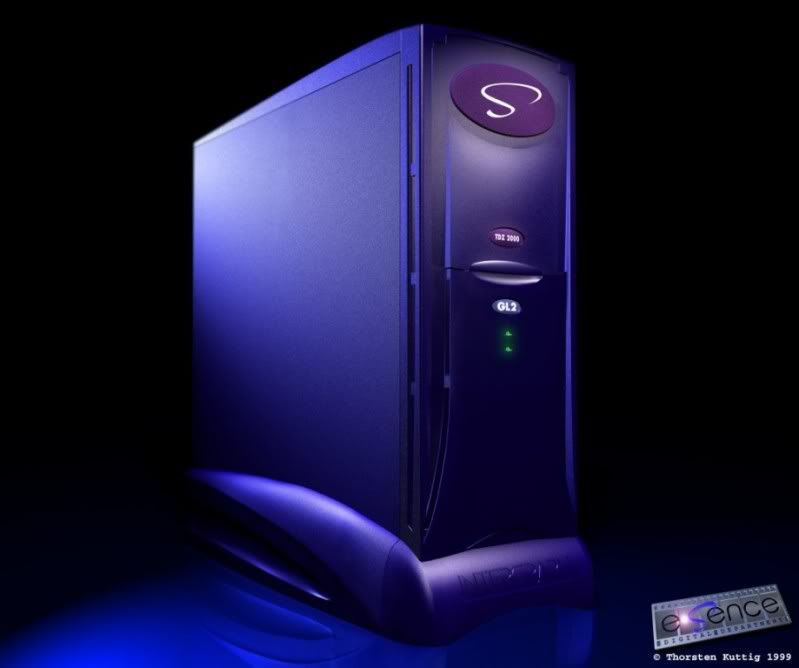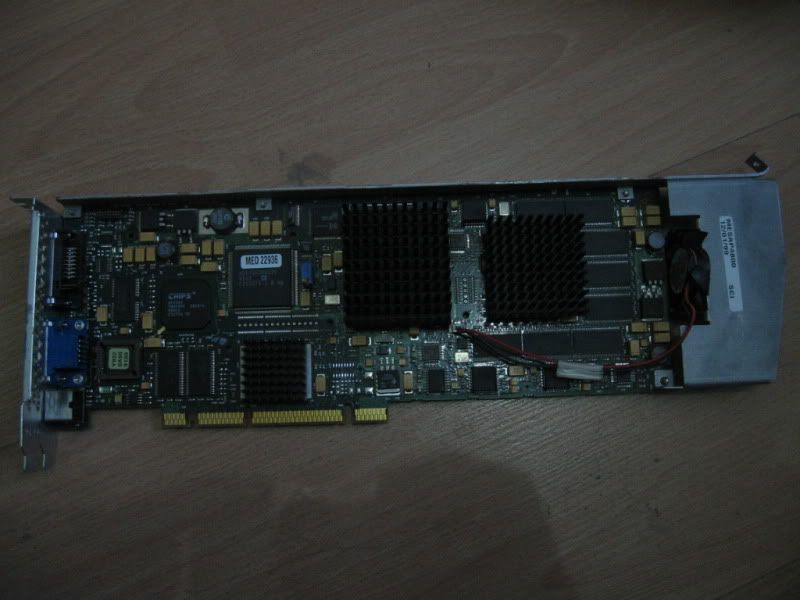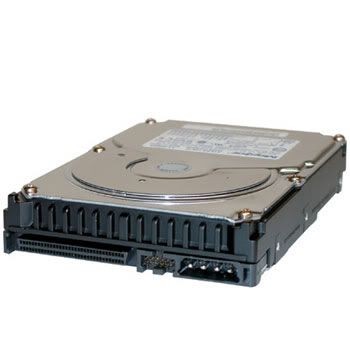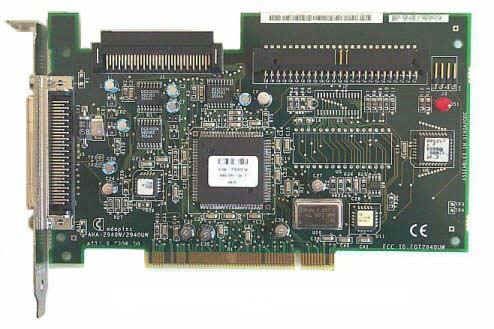alienware
Banned
Ahh, them were the days. I started working in a computer business in 1998. And that's where I became incredibly irresponsible. At the time I was living at home in London, so my outgoings were about £80 a week. I was earning well clear of £500. With that much money to throw around and very little responsibility the world of computers was like crack haha. I got my first taste of dual CPUs with a machine I used to use (and took ownership of) at work. It was Dual Pentium Pro. This was basically where they got the tech for the P2.
Piccy.

There it is sitting next to a flip chip Celeron. FCPGA.. They adapted that for the P3 coppermine flip chips.. It was basically to get rid of Slot 1.
Any way, I then got a taste of xeons and LVD. We built a server for a local school (well, I did) and it had dual P2 Xeons that were clocked to 450 with 1mb L2 cache. That may not sound much cache but if you consider at the time that 256 was the max (k that is) then 1mb was absolutely whopping. The clever trick with the Xeon however was how the cache was full clock speed and not just the bus speed (which was 100mhz back then, and had evolved from 66). The Intel LX chipset was a 66 bus (early P2 slot 1) and the 100mhz bus was introduced for the P2 350, 400 and 450. At which point they switched to a slot 1 p3 and they began and 450 and went up to 600 before they changed the bus to 133 and the 633 p3 was born.
Any way, back to the xeons. Yes, this server just kicked ass. It was so quick that I had never seen anything like it.. I had the taste for it then

My first Xeon based machine was a IBM Intellistation Z pro. Basically it had a 440GX based board in but carried the MS (Marlinspike) tag before the 440. This meant it had an AGP slot, meaning you could game with it. At the time 2000 was released and some one had written a hacked version of DX8 for it, so it was ready to game. My IBM housed a 32mb 3DLabs Oxygen with two 8mb Voodoo 2 cards. It was insanely fast and IIRC I spent about £2500 on it. Shortly afterward I decided to go off to America and so I sold it.
Upon arriving in America the first thing I did was hit Ebay. Right back when Ebay was in its infancy and stuff on there was super cheap. People saw it as a way of getting rid of their crap then and not a way to demand top money for old sh*te.
Now bear in mind that at that time modding and custom cases were not even around. You had a choice. Go with IBM and get black, or build your own and get beige. With that in mind take a look at what I managed to get for $1000.

I mean really, it was silicon sex. When people came to my house they would ask me what the hell it was, not even realising it was a computer. But what was important was what was inside. IIRC it was old stock because Intergraph (it's an Intergraph Z2000 btw, they built graphic workstations but went out of business)
Inside it was just ridiculous. The motherboard was the MS440GX and as hard as I have tried I cannot find a photo. But here is the pic from the manual.

Note the red line? That cuts off a normal ATX motherboard. This thing was absolutely ENORMOUS. On the farthest right you can see the slots for the Xeons. The Xeons looked like this.

About the size of a VHS tape. Mine were P3500 with 2mb L2. Again, full speed. They were so big and heavy once the sinks were on that the socket had a bracket that bolted over the top of the CPUS holding them in. Otherwise they would have cracked the sockets clean off the board. If you take another look back at the motherboard look for fig K. That was where the VRM went if you were using dual CPUs. Nothing was onboard.
For the video card I had one of these, a 256mb 3DLabs Wildcat 2. If you think about it you'll realise just how ridiculous that is. 256mb in an era where if you had 64mb you were rich. It also sported dual GPUs in SLI and retailed at around $1200. Pic, of the AGP pro slot version (cant find one of the normal one :S)

Moving onto storage. At that time there was a technology called LVD SCSI. LVD basically stood for low voltage drive. Meaning they were 5v and you could hot swap them with a bay. This was primarity designed for servers, because if a drive was faulty you could just pull it and replace it without shutting the server down. However, the reason enthusiasts went for it was it's insane 15,000 RPM spindle speeds. In a day where drives were 5400.I was using three 4.3gb Baracudas that looked a little something like this.

And they were all connected to this. Fabled as the best SCSI card ever invented, the 2940W by Adaptec.

My optical drive was a 2x Ricoh SCSI CDRW. I took it over from the UK.
And that was about the most expensive fastest (at the time) machine I ever had. Then the responsibility of being married kicked in and for the next decade the best I had was an Athlon XP with a 5900u. After that (I had to sell it to pay for the paint on the car) I had a Celeron D for about four years.
Poor me


Piccy.

There it is sitting next to a flip chip Celeron. FCPGA.. They adapted that for the P3 coppermine flip chips.. It was basically to get rid of Slot 1.
Any way, I then got a taste of xeons and LVD. We built a server for a local school (well, I did) and it had dual P2 Xeons that were clocked to 450 with 1mb L2 cache. That may not sound much cache but if you consider at the time that 256 was the max (k that is) then 1mb was absolutely whopping. The clever trick with the Xeon however was how the cache was full clock speed and not just the bus speed (which was 100mhz back then, and had evolved from 66). The Intel LX chipset was a 66 bus (early P2 slot 1) and the 100mhz bus was introduced for the P2 350, 400 and 450. At which point they switched to a slot 1 p3 and they began and 450 and went up to 600 before they changed the bus to 133 and the 633 p3 was born.
Any way, back to the xeons. Yes, this server just kicked ass. It was so quick that I had never seen anything like it.. I had the taste for it then
My first Xeon based machine was a IBM Intellistation Z pro. Basically it had a 440GX based board in but carried the MS (Marlinspike) tag before the 440. This meant it had an AGP slot, meaning you could game with it. At the time 2000 was released and some one had written a hacked version of DX8 for it, so it was ready to game. My IBM housed a 32mb 3DLabs Oxygen with two 8mb Voodoo 2 cards. It was insanely fast and IIRC I spent about £2500 on it. Shortly afterward I decided to go off to America and so I sold it.
Upon arriving in America the first thing I did was hit Ebay. Right back when Ebay was in its infancy and stuff on there was super cheap. People saw it as a way of getting rid of their crap then and not a way to demand top money for old sh*te.
Now bear in mind that at that time modding and custom cases were not even around. You had a choice. Go with IBM and get black, or build your own and get beige. With that in mind take a look at what I managed to get for $1000.

I mean really, it was silicon sex. When people came to my house they would ask me what the hell it was, not even realising it was a computer. But what was important was what was inside. IIRC it was old stock because Intergraph (it's an Intergraph Z2000 btw, they built graphic workstations but went out of business)
Inside it was just ridiculous. The motherboard was the MS440GX and as hard as I have tried I cannot find a photo. But here is the pic from the manual.

Note the red line? That cuts off a normal ATX motherboard. This thing was absolutely ENORMOUS. On the farthest right you can see the slots for the Xeons. The Xeons looked like this.

About the size of a VHS tape. Mine were P3500 with 2mb L2. Again, full speed. They were so big and heavy once the sinks were on that the socket had a bracket that bolted over the top of the CPUS holding them in. Otherwise they would have cracked the sockets clean off the board. If you take another look back at the motherboard look for fig K. That was where the VRM went if you were using dual CPUs. Nothing was onboard.
For the video card I had one of these, a 256mb 3DLabs Wildcat 2. If you think about it you'll realise just how ridiculous that is. 256mb in an era where if you had 64mb you were rich. It also sported dual GPUs in SLI and retailed at around $1200. Pic, of the AGP pro slot version (cant find one of the normal one :S)

Moving onto storage. At that time there was a technology called LVD SCSI. LVD basically stood for low voltage drive. Meaning they were 5v and you could hot swap them with a bay. This was primarity designed for servers, because if a drive was faulty you could just pull it and replace it without shutting the server down. However, the reason enthusiasts went for it was it's insane 15,000 RPM spindle speeds. In a day where drives were 5400.I was using three 4.3gb Baracudas that looked a little something like this.

And they were all connected to this. Fabled as the best SCSI card ever invented, the 2940W by Adaptec.

My optical drive was a 2x Ricoh SCSI CDRW. I took it over from the UK.
And that was about the most expensive fastest (at the time) machine I ever had. Then the responsibility of being married kicked in and for the next decade the best I had was an Athlon XP with a 5900u. After that (I had to sell it to pay for the paint on the car) I had a Celeron D for about four years.
Poor me
